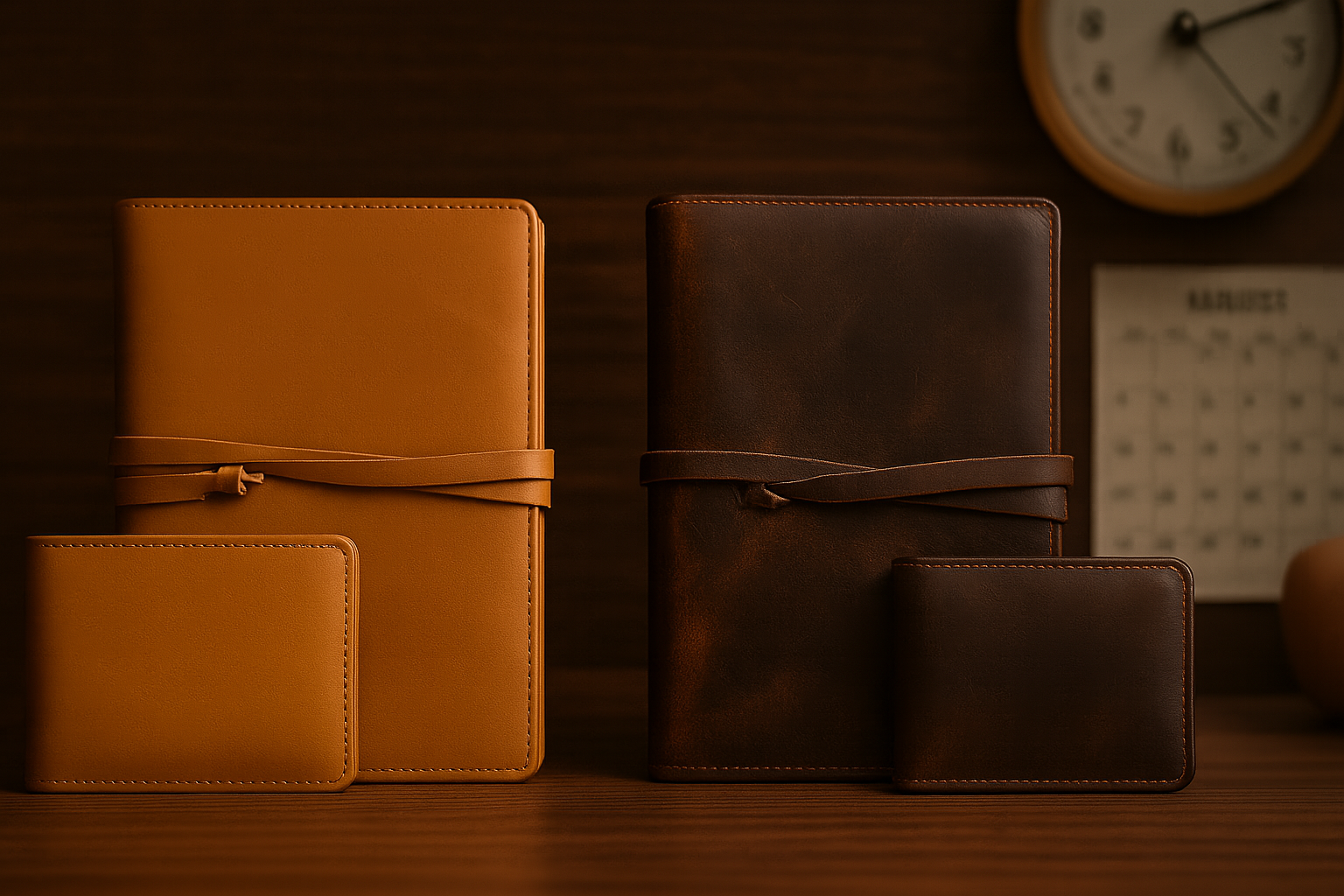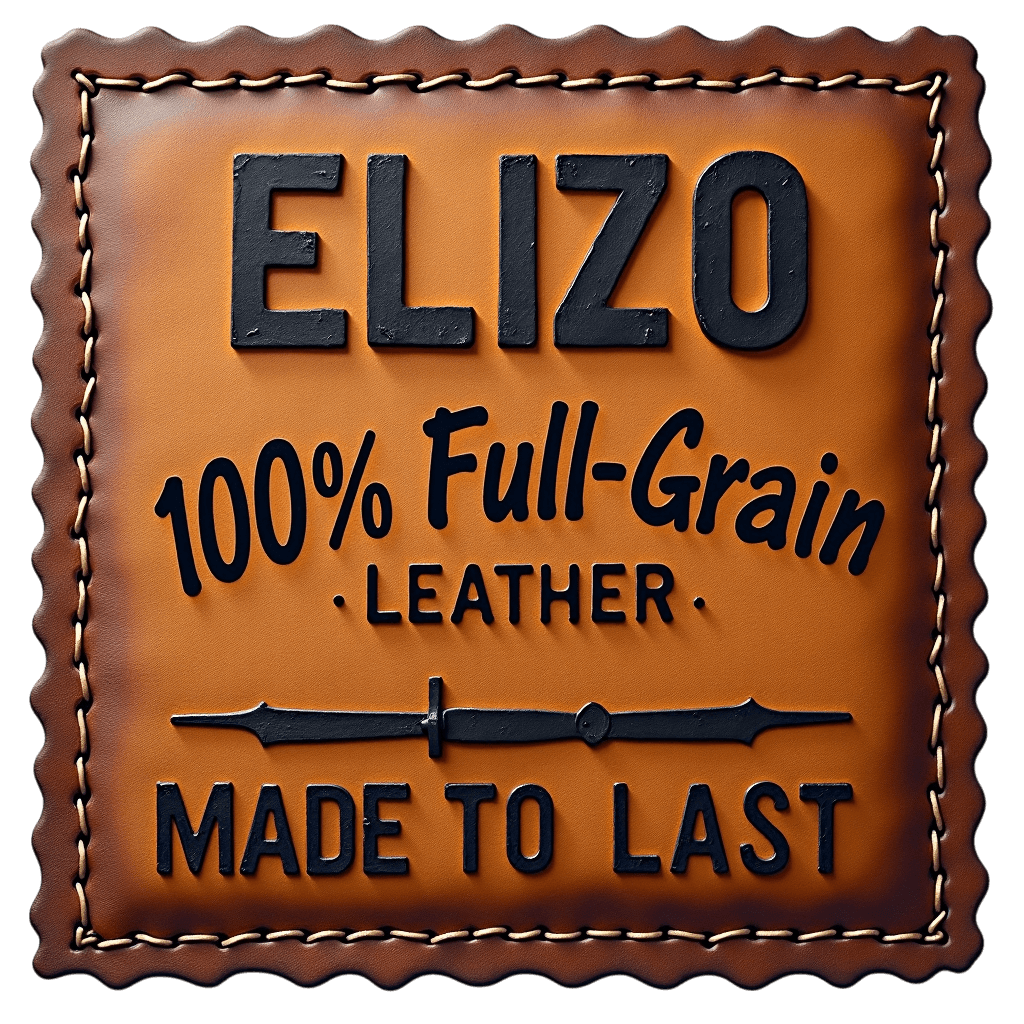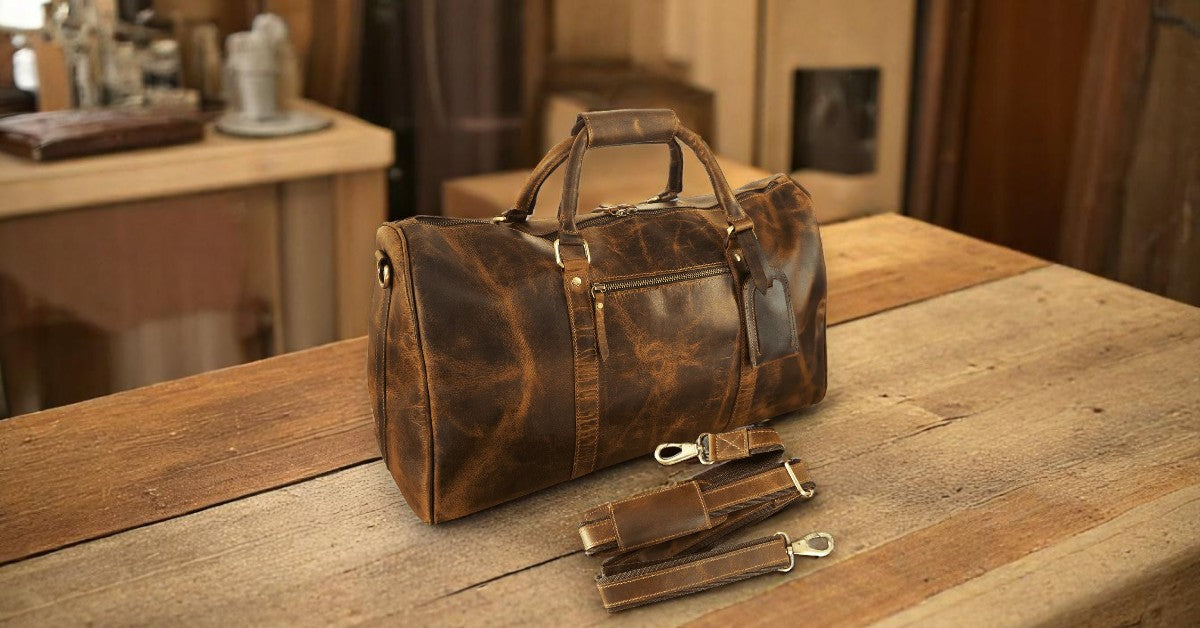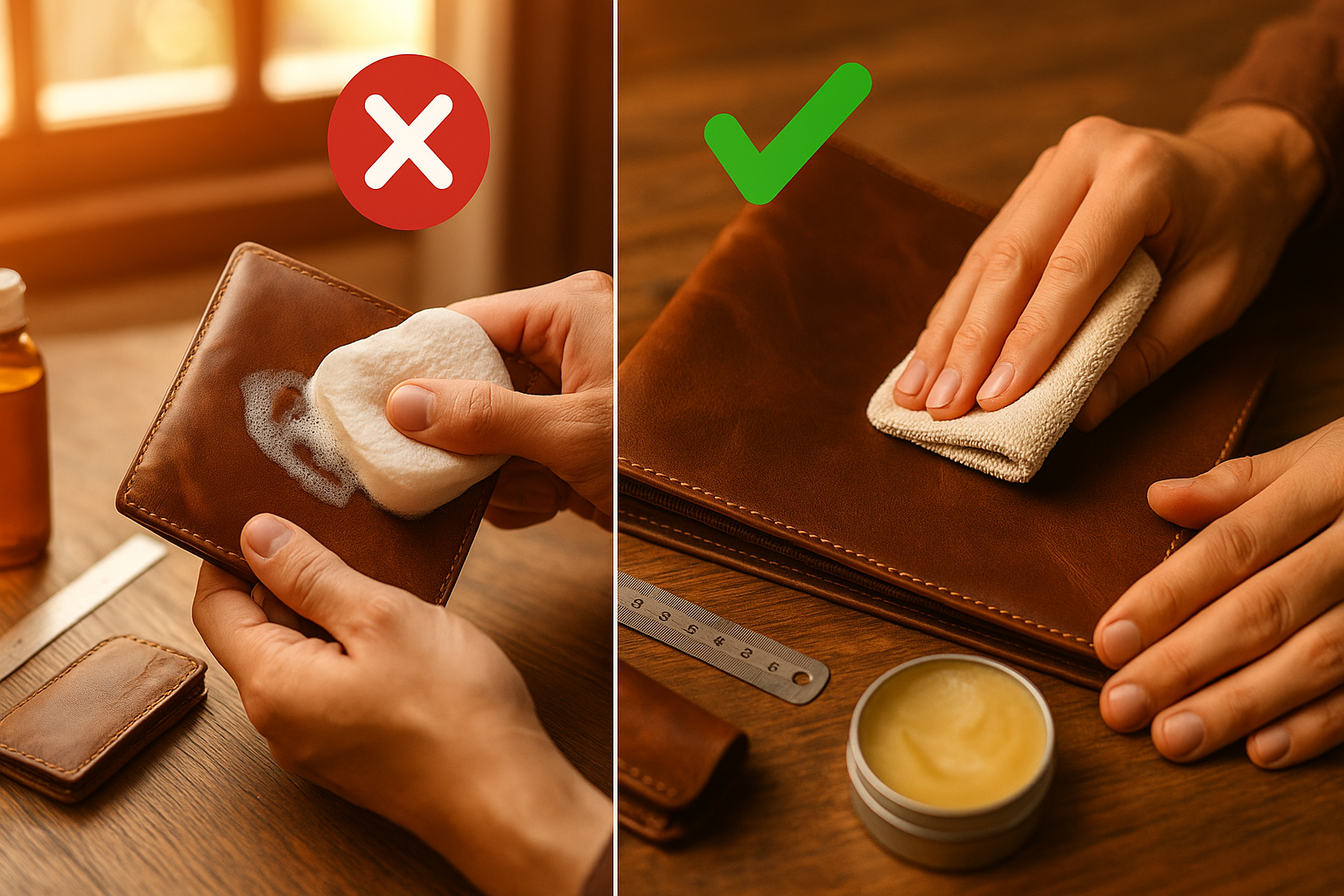
Understanding Leather Patina: How Quality Leather Ages and Develops Character

One of the most compelling aspects of quality leather goods is their ability to improve with age, developing rich patina and unique character that tells the story of their use and care. Unlike synthetic materials that simply wear out, premium leather evolves through a natural aging process that enhances beauty while maintaining structural integrity and functional performance.
Understanding patina development helps leather enthusiasts appreciate the journey their accessories will take while making informed decisions about leather types, care routines, and usage patterns that influence aging characteristics. From full-grain leather wallets that develop golden honey tones to executive briefcases that gain distinguished character marks, proper aging transforms functional accessories into treasured possessions.
The Science of Leather Patina Formation
Patina development results from complex interactions between leather fibers, natural oils, environmental factors, and handling patterns that create unique surface characteristics and color changes over time through natural chemical and physical processes.
Chemical Processes in Aging
Oxidation reactions between leather components and environmental elements create color changes and surface characteristics that define patina development. These chemical processes occur naturally and can be influenced by care products, environmental exposure, and handling frequency.
Natural oil migration within leather fibers creates surface richness while internal lubrication maintains flexibility and prevents cracking. This oil movement responds to temperature, humidity, and mechanical stress from regular use throughout the aging process.
Tannin interactions with light and oxygen create color development while preserving leather integrity. Different tanning methods produce varying aging characteristics that influence both appearance and durability throughout extended use periods.
Physical Wear and Character Development
Mechanical stress from handling creates distinctive wear patterns while surface burnishing from friction develops smooth, lustrous areas that contrast with less-handled regions to create visual depth and character.
Compression and stretching from regular use create texture variations while maintaining structural integrity. These physical changes contribute to patina development while preserving functionality throughout intensive daily use.
Environmental exposure including UV light, humidity variations, and temperature changes accelerate aging processes while creating distinctive characteristics that reflect usage patterns and environmental conditions throughout ownership periods.
Types of Leather and Their Aging Characteristics
Different leather types develop distinctive patina patterns based on their processing methods, natural characteristics, and structural properties that influence both aesthetic development and functional aging.
Full-Grain Leather Patina Development
Full-grain leather develops the most dramatic and beautiful patina due to its complete natural grain structure that retains all original characteristics while allowing natural aging processes to create complex color and texture development.
Natural grain patterns become more pronounced through aging while surface characteristics develop unique combinations of smooth and textured areas that reflect individual usage patterns and environmental exposure throughout ownership.
Color development in full-grain leather typically progresses from lighter original tones to deeper, richer hues while maintaining clarity and depth that synthetic finishes cannot replicate throughout natural aging processes.
Scratch and mark integration allows minor damage to become part of the leather's character while maintaining structural integrity and aesthetic appeal throughout extended use and environmental exposure.
Top-Grain and Corrected Leather Aging
Top-grain leather develops more subtle patina characteristics while maintaining consistent appearance due to surface processing that removes some natural variation but preserves aging capabilities within controlled parameters.
Corrected-grain leather shows minimal patina development due to protective surface treatments while maintaining durability and consistent appearance that appeals to users preferring predictable aging characteristics.
Pigmented leather finishes influence aging patterns while protecting underlying leather from environmental damage. These treatments can slow patina development while ensuring color consistency throughout extended ownership periods.
Vegetable-Tanned vs. Chrome-Tanned Characteristics
Vegetable-tanned leather develops rich, warm patina with dramatic color changes while maintaining natural characteristics that respond beautifully to environmental exposure and regular handling throughout aging processes.
Chrome-tanned leather shows more subtle aging while maintaining flexibility and consistent performance. These leathers develop character through use while retaining their original color characteristics throughout extended ownership.
Combination tanning methods create unique aging characteristics while balancing rapid patina development with durability and performance requirements throughout demanding use conditions and environmental exposure.
Environmental Factors Influencing Patina
Environmental conditions significantly impact patina development while understanding these influences helps leather owners guide aging processes to achieve desired characteristics and prevent unwanted damage.
Light Exposure and UV Effects
Sunlight exposure accelerates color development while UV radiation can cause fading or unwanted color changes if exposure exceeds optimal levels. Controlled light exposure enhances patina while excessive exposure can damage leather structure.
Indoor lighting conditions influence aging patterns while artificial light sources create different effects compared to natural sunlight. Understanding these variations helps predict and control patina development throughout different usage environments.
Seasonal variation in light exposure creates natural aging cycles while consistent exposure patterns develop uniform patina characteristics throughout extended ownership and regular use patterns.
Humidity and Temperature Influences
Humidity levels affect oil migration and surface development while extreme conditions can accelerate or inhibit natural aging processes. Optimal humidity ranges support healthy patina development while preventing mold or excessive drying.
Temperature variations influence chemical reaction rates while thermal cycling can enhance or damage aging processes depending on severity and duration of environmental exposure throughout ownership periods.
Climate adaptation allows leather to develop region-specific characteristics while environmental stability supports consistent patina development throughout varied seasonal conditions and geographic locations.
Usage Patterns and Handling Effects
How leather goods are used and handled directly influences patina development while understanding these relationships helps owners guide aging processes to achieve desired characteristics and prevent unwanted wear.
Frequency of Use Impact
Regular handling accelerates patina development while creating distinctive wear patterns that reflect individual usage habits and preferences. Frequently used items like daily carry wallets develop faster aging than occasionally used pieces.
Contact points and high-wear areas develop distinctive characteristics while less-handled regions retain more original appearance, creating visual contrast that defines character and personality throughout aging processes.
Rotation patterns for multiple leather goods can create different aging characteristics while allowing controlled development and preventing excessive wear on individual pieces throughout collection management.
Handling Style and Care Patterns
Gentle handling preserves surface integrity while allowing natural aging while rough use can accelerate character development but might compromise structural integrity throughout extended ownership periods.
Oil transfer from skin contact enhances patina development while creating personalized characteristics that reflect individual chemistry and handling patterns throughout regular use and care routines.
Care product application influences aging while proper conditioning supports healthy patina development and prevents cracking or damage throughout environmental exposure and regular use patterns.
Accelerating vs. Preserving Natural Aging
Leather owners can influence aging processes through care choices and usage patterns while balancing desire for character development with preservation of structural integrity and functional performance.
Natural Aging Enhancement Techniques
Controlled environmental exposure can accelerate aging while maintaining leather health through careful management of light, humidity, and temperature exposure throughout guided patina development processes.
Gentle massage and handling techniques enhance oil distribution while promoting even aging and character development throughout regular care routines and maintenance practices.
Appropriate conditioning products support aging while providing necessary nutrients and protection throughout accelerated development without compromising structural integrity or long-term durability.
Preservation and Slowing Aging
Protective care products can slow aging while preserving original appearance for users preferring minimal character development throughout extended ownership and regular use patterns.
Environmental control through storage and usage patterns prevents excessive aging while maintaining leather condition and appearance throughout varying exposure conditions and climate variations.
Professional treatment can restore or modify aging characteristics while preserving leather integrity and functional performance throughout restoration and maintenance processes.
Regional and Cultural Aging Preferences
Different cultures and regions have varying preferences for leather aging characteristics while understanding these differences helps appreciate diverse approaches to patina development and leather care.
Japanese and Asian Leather Culture
Japanese leather culture emphasizes controlled aging and meticulous care while developing subtle, refined patina characteristics that reflect attention to detail and respect for materials throughout ownership periods.
Asian leather working traditions focus on slow, deliberate aging while creating distinctive characteristics that honor traditional techniques and cultural values throughout careful development processes.
European Heritage Approaches
European leather traditions embrace natural aging while accepting character marks and wear patterns as evidence of quality and authenticity throughout extended ownership and traditional usage patterns.
Traditional European care methods support aging while maintaining structural integrity through time-tested techniques and natural products throughout heritage preservation and cultural continuity.
American Utilitarian Perspectives
American leather culture often emphasizes functional aging while accepting wear patterns that demonstrate utility and reliability throughout demanding use conditions and practical applications.
Frontier and work traditions influence aging acceptance while creating distinctive American approaches to leather care and character development throughout cultural heritage and practical requirements.
Patina Development by Product Type
Different leather goods develop characteristic aging patterns based on their usage patterns, construction methods, and environmental exposure throughout their intended applications and ownership experiences.
Wallet and Small Accessory Aging
Leather wallets develop distinctive pocket wear while creating unique aging patterns from card edges, currency contact, and handling friction throughout daily use and regular access patterns.
Body heat and moisture from carrying create accelerated aging while skin oil transfer enhances patina development in contact areas throughout extended ownership and daily use routines.
Edge wear and corner rounding develop character while maintaining structural integrity through quality construction that supports aging without compromising functionality throughout intensive daily use.
Bag and Briefcase Patina
Leather briefcases develop handle wear and corner scuffing while creating professional patina that enhances rather than diminishes business presentation throughout career advancement and professional use.
Messenger bags show strap wear and body contact areas while developing distinctive patterns from urban use and varied carrying positions throughout daily commuting and professional activities.
Tote bags develop rim wear and handle patina while showing characteristic aging from loading patterns and carrying styles throughout diverse usage scenarios and lifestyle applications.
Desk Accessory and Stationary Aging
Leather desk pads develop writing wear and ink staining while creating unique work surface characteristics that reflect professional activities and personal work habits throughout career development.
Leather journals show spine wear and cover aging while developing personal characteristics from handling patterns and environmental exposure throughout creative and professional use.
Document holders and padfolios develop edge wear and surface patina while maintaining professional appearance through controlled aging that enhances rather than diminishes business presentation.
Common Patina Development Issues
Understanding potential problems in aging processes helps leather owners prevent unwanted outcomes while promoting healthy patina development and preserving long-term leather quality and appearance.
Uneven Aging and Color Variation
Inconsistent exposure or care can create uneven aging while proper handling and maintenance promote uniform patina development throughout balanced aging processes and regular care routines.
Environmental variations cause patchy development while consistent conditions support even aging and character development throughout controlled exposure and careful maintenance practices.
Usage pattern modifications can address uneven aging while promoting balanced development through adjusted handling and care routines throughout corrective aging management.
Excessive Wear and Damage
Over-aging can compromise structural integrity while proper care balances character development with preservation throughout extended ownership and regular use patterns.
Environmental damage from excessive exposure requires professional treatment while prevention through proper care maintains aging within acceptable parameters throughout ownership periods.
Restoration techniques can address aging issues while preserving desirable characteristics and maintaining structural integrity throughout professional treatment and ongoing maintenance.
Caring for Aging Leather
Proper care supports healthy aging while preventing damage and promoting desirable patina characteristics throughout extended ownership and regular use patterns.
Age-Appropriate Care Routines
Newly aged leather requires gentle care while established patina benefits from maintenance routines that preserve character while supporting continued development throughout aging progression.
Conditioning frequency adjustments support aging while preventing over-treatment that might interfere with natural development throughout balanced care and maintenance routines.
Product selection for aging leather considers patina preservation while providing necessary protection and maintenance throughout continued development and environmental exposure.
Professional Assessment and Treatment
Expert evaluation identifies aging issues while providing solutions that preserve desirable characteristics and address problems throughout professional intervention and ongoing care.
Restoration services can enhance aging while maintaining authenticity and character throughout professional treatment that supports continued development and long-term preservation.
Maintenance planning for aging leather ensures continued health while supporting desired development throughout structured care and professional support services.
Collecting and Appreciating Patina
Leather enthusiasts often develop appreciation for patina characteristics while building collections that showcase different aging patterns and development stages throughout diverse ownership experiences.
Building Patina Collections
Diverse leather types create varied aging experiences while collection building allows comparison and appreciation of different patina characteristics throughout ownership and development observation.
Age rotation strategies allow controlled development while ensuring collection pieces receive appropriate use and care throughout balanced aging and preservation practices.
Documentation and photography preserve aging progression while creating records that demonstrate development and support appreciation throughout collection management and character observation.
Community and Sharing
Leather communities share aging experiences while providing support and advice throughout patina development and collection building activities among enthusiasts and collectors.
Social media and forums document aging while creating resources for learning and appreciation throughout community participation and knowledge sharing among leather enthusiasts.
Expert guidance supports aging appreciation while providing education and resources throughout continued learning and collection development among dedicated enthusiasts.
Conclusion: Embracing the Journey of Leather Aging
Understanding leather patina development enhances appreciation for quality leather goods while supporting informed decisions about care, usage, and collection building throughout extended ownership experiences and character development.
The journey of leather aging transforms functional accessories into personal treasures while creating unique characteristics that reflect individual ownership and care throughout natural development processes and environmental interaction.
Whether appreciating the subtle development of a professional portfolio or embracing the dramatic transformation of a travel duffle bag, understanding aging processes enhances satisfaction while supporting proper care throughout ownership periods.
Remember that patina development represents the collaboration between quality materials, careful craftsmanship, and thoughtful ownership while creating accessories that improve rather than deteriorate throughout extended use and environmental exposure.
Embrace the aging process as an opportunity to participate in leather's natural evolution while supporting healthy development through proper care and appreciation throughout the unique journey that each piece experiences.
For quality leather goods designed to age beautifully while maintaining structural integrity and functional performance, choose pieces that reward proper care with decades of character development and increasing personal significance throughout their natural aging journey.




